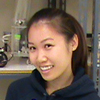Fellows
 Carole Chen
Carole Chen
M.S. (2nd year), Chemical and Biological Engineering
Year in graduate program: 2nd year (September 2009)
Research Topic: Dynamics of Polymeric Thin Films
Partner School:PS 3 The Bedford Village
Partner Teacher:Lynette McCord & Ryan Cain
Email Carole
Research
Under the guidance of Prof. Jovan Mijovic, Carole is studying the dynamics of polymeric thin films using dielectric relaxation spectroscopy (DRS). This technique is based on applying alternating electrical field that perturbs the molecules and captures molecular motions of various length scales and time scales. For instance, one can detect length scales that range from the motions of entire chains to those of small side groups and time scales that vary from hundreds of seconds to picoseconds. Carole's research is focused on understanding the difference in behavior between polymeric materials in bulk versus thin films that range from 1 to 100 nanometers. Dynamics parameters such as glass transition temperatures and the average relaxation time, major materials characteristics that determine the macroscopic behavior, are observed to be different in thin films. This has important consequences in applications. The ultimate goal of Carole's work is to understand the molecular dynamics at the nanoscopic level in order to be able to design macroscopic systems with desired characteristics. Her study also includes the application of the same methodologies to investigate dynamics of biological polymers such as DNA molecules tethered to a solid surface. These systems hold promise for applications in microarrays and biosensing technologies.
Figure: Carole Chen removing a thin-film sample out of the sample cell of dielectric relaxation spectroscopy (DRS) once the measurements are done.
Integration in The Class Room
Carole introduces the fundamental concept of sensors at various levels to elementary school students (5th graders). She gets students accustomed to the different types of sensors (e.g. touch, light, and ultrasonic sensors) in the LEGO Mindstorms kit. She then broadens these concepts by drawing upon her own research that focuses on the development of sensors for use in the rapidly growing field of nanotechnology. Students are introduced to the concepts of nanotechnology by first learning international systems of units using scientific notations to represent the extremes in length scales: e.g., from kilometers all the way down to nanometers, so that they can appreciate the concept of scaling. The lessons are followed by a variety of practical examples in everyday life designed to help students differentiate between macroscopic and nanoscopic dimensions. For instance, in an activity designed to help students understand the concept of pi; students measured the circumferences and diameters of circles using the traditional method of a ruler. The lesson was broadened with the use of LEGO Mindstorms kit when students built robots that use light sensor to track the circumference of the circle and then using the knowledge of the total rotations traversed by the robot's wheels, they can back-calculate the estimated distance traveled by the robot via a simple relationship between pi, circumference, and diameters of the wheels: C=ΠD. As assessment, students were asked to convert all the measured lengths into different length units, e.g. miles, inches, millimeters, nanometers, etc. Another activity involved estimating the growth of human nails in a week's time and from this students were asked to estimate rate of growth in nanometer per hour and conversion of measurement to variety of units. From these activities, students learn that sensors apply not only to large, familiar mechanical objects but they are also pervasive in biological systems allowing biosensing to play a major role in our health and wellness.
Figure: Carole explains the International System of Units to 5th graders.
1 - AMPS Fellow; 2 - CBRI Fellow